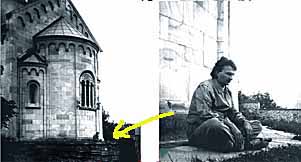(Spi)ritual Performance
by Andrej Tisma

The classical definition of performance art is a live artistic action where a variety of media are used, and where the artist, whose role is central, affects the audience on an emotional and intellectual level. It is usually compelling in its visual, sound, and verbal forms, and leads to a catharsis. In order to affect the audience, performance art is usually shocking, violent, or strange in manifestation, basing its influence on external effects and sensations.
In (spi)ritual, the kind of performance art I practice, the stress is on an internal transformation of the artist and the audience. In a way, it is working with human psyche as artistic material. Visually, it is simple. I use the methods of lecture, conversation, distribution of printed matter, slide projections, and manipulation of some ordinary objects and natural materials. More important is what is happening on the spiritual level, which is invisible, but powerful. I could define it as a transmission of spiritual energy or inspiration from the artist to the audience with specific feed-back. So, (spi)ritual does not work on the level of the senses or intellect, and that's why the visual, sound, or verbal components don’t need to be compelling. Instead, it is based on a spiritual exchange during the direct contact between the artist and spectator. Any techniques, objects, or materials used merely support that exchange.
(Spi)rituals are usually based on telepathy, magic, and on a shamanistic tradition from the past. (Spi)rituals are attempts to transmit artistic inspiration directly, without an intermediary.
August 3, 1991
[Andrej
Tisma (Novi
Sad, Yugoslavia, 1952) graduated from Academy of Fine Arts in Prague,
Czechoslovakia in 1976. From the early '70s Tisma was concerned with concrete
poetry, mail-art, photography, xerox, and since '80s with performance
art and video. He has had solo exhibitions beginning in 1972 in Novi Sad,
Belgrade, New York, Milan, Seoul, Munich, Naples, and San Francisco. Since
1996 Tisma has been working in the field of digital graphics and web-art.
He has been publishing art criticism and essays since 1976. Tisma lives
in Novi Sad, Serbia and Montenegro working as an artist, art critic, and
curator.]